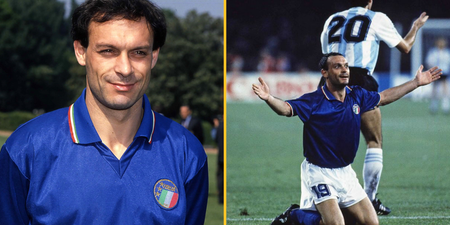Lionel Messi’s dinked finish over Manuel Neuer, Joe Canning’s instinctive All-Ireland final goal, a Sonny Bill Williams offload – elite sport retains that almost unique ability to lift us out of our seats.
Increased professionalism, booming prize funds and more sophisticated coaching have seen standards rise globally in both team and individual sports, with most agreeing that individual skills now far surpass what has gone before.
Observe Neymar controlling a football as if it were on a string, stare in wonder at Serena Williams’ ability to run an opponent ragged from the baseline or marvel at Diarmuid Connolly’s unerring accuracy off either foot – the sports we love are studded with individuals capable of mesmeric moments.
“Performances in most sports have improved a great deal in half a century,” Matthew Syed tells SportsJOE. “Mostly this is down to better coaching, psychology, diet and better practice.
“Just look at video tapes of 40 years ago. Levels of skill have increased, not just talent identification but also coaching.”
Syed, a two-time British table tennis Olympian, examined the primacy of practice over talent in his book “Bounce”, in which he endorses the theory famously posited by Malcolm Gladwell that at least 10,000 hours of practice are required to be considered an expert in any endeavour.
That’s one year of solid practice. After a year of practice most of us could not make a football talk like Neymar or Messi, or laser tennis shots like Williams, but could we become fit and strong enough to at least prevent them from fully expressing their talents?
Skill levels may be increasing but there is growing concern in some quarters that improvements in strength and conditioning are outstripping these advances, changing the way some sports are played, to the detriment of the very moments of skill for which we watch sport.
The signs are there. From David Walsh calling for a maximum weight to be imposed on rugby players, to Tyrone GAA secretary fearing the Association is becoming a “training and coaching industry”, or Arsene Wenger complaining that European academies have stopped producing centre-forwards.
Is top level sport being damaged by a focus on strength and conditioning and a culture of over-coaching?
Paudie Butler was no slouch as a player. A dual star in the late 1970s, he had the misfortune of playing on Tipperary teams that were regularly outgunned by a Cork hurling side inspired by another two-code gem by the name of Jimmy Barry Murphy and, on the front, in Kerry, arguably the greatest football team of all time.
So the former national director of hurling isn’t being glib when he matter-of-factly tells SportsJOE that the skill levels possessed by today’s 10-12 year olds outstrips those of intercounty stars of his vintage. JBM, Spillane, Páidí Ó Sé… they can’t hold a candle to what you’ll see in this summer’s blitzes.
“The skill levels have gone up every decade, fairly rapidly. [However] the whole thing has been overtaken with speed, strength and the ability of players to endure the 70 minutes, whereas before things might have opened up a bit after half-time. Now people can go 70, 80, 90 minutes without losing energy or form.”
Take the two examples above. Butler’s exhaustive research in the area tells us Kilkenny’s goal-scorer in last year’s All-Ireland final, TJ Reid, took 0.8 seconds to receive that pass from Walter Walsh and blast the ball to the net. Had he taken 0.9 seconds he would have been blocked by one or both of Johnny Coen and John Hanbury.

In 2001, Wexford’s Larry O’Gorman displayed incredible ingenuity and sleight of hand in the second half of an All-Ireland semi-final to lift the sliotar, tap it over the head of Tipperary’s Paul Ormonde and drive a shot past Brendan Cummins.
It is a wonderful piece of skill that almost certainly would not be allowed happen now. Applying today’s standards, a stronger more agile Ormonde would have stopped O’Gorman in his tracks and, if he didn’t, full-back Philip Maher would have got across quick enough to make the block.
“We crave for this creativity, we crave these wondrous moments, but they are happening in congested areas,” says Butler, who advocates fewer numbers on Gaelic football and hurling teams so that skilful players can be given space.
“It used to be accepted in Gaelic games that it was a one-on-one, now it’s a three-on-one or a four-on-one, it has tended that way of late,” he says. “We saw glorious eras of great players, who were full of creativity – the Maurice Fitzgeralds and those and Nicky Englishes and those,” adds Butler.
“There is a lot of those players now with a very high level of skill, whose early ball control is phenomenal. They’re not getting the reward of it, because we won’t have time to enjoy them in isolation. The fitness levels now required are very demanding and an unfit player with high skill levels wouldn’t survive at all, at all, he wouldn’t get to the park.”
That emphasis on fitness rings true with Bobby Byrne. Director of rugby at University College Dublin (UCD), Byrne believes the ever-increasing role of strength and conditioning means that young men with ambitions of playing at the highest level need to start on S&C programmes before they leave school.
While he accepts the health concerns associated with such training being undertaken unsupervised or implemented incorrectly, he highlights the obvious dangers of trying to play top-level rugby without adding the necessary bulk.
“The game is at it is, whether we like it or not, in order for a guy to become a professional rugby player a lot of them feel they need to do the conditioning work to get bigger in order to survive,” says Byrne.
Now retired, Brian O’Driscoll has expressed concerns with rugby’s emphasis on size and strength and it is arguable that the greatest Irish player of modern times, by no means a giant, would not make the cut were he to emerge today.
“They should be rugby players becoming athletes, not athletes becoming rugby players,” was O’Driscoll’s note of caution back in 2014.
When you compare the third try of O’Driscoll’s famous Paris hat-trick with Jared Payne’s score at Murrayfield (above) you get a sense of how rugby has changed in a decade and a half.
Granted they are two snapshots in time, but O’Driscoll’s 2000 effort is a moment of improvisation made possible after a flowing passage of running rugby. Payne’s clever line comes after phase upon phase of attritional running straight at the Scottish defence.
Byrne accepts the game has become more structured but he believes the right coach can still give talent the freedom to express itself.
“Certainly at adult level the players are being fed a huge amount of information and a lot of feedback about performance individually and on a team basis,” he tells SportsJOE.
“Some coaches still encourage heads-up rugby, some other coaches have a much more structured approach. We play a certain way in certain parts of the pitch.”
Having helped the talents of Damien Duff and Robbie Keane flourish as teenagers, Brian Kerr remains confident that football is still a sport in which skill trumps fitness. Speaking to SportsJOE, the former Republic of Ireland manager expressed the view that, in many ways talents like Messi now face fewer physical challenges than predecessors such as George Best.
“Both had physical and mental strength to survive. You would say in Best’s era it was a slower game, defenders weren’t as quick, but in his time rules were different, fellas used to go on to the pitch with the intention of trying to kill him, to kick him off the pitch.
“There would be guys lining up. You don’t have the same level of tackling now. The best players of different eras adapt to the challenges of the game,” says Kerr.
What of Wenger’s concern that South America is the only place in the world now producing natural centre-forwards as European academies churn out a conveyor of attacking midfielders?

This Kerr does lay at the feet of coaches, but he blames their preferred tactics instead of any failure in the development of youngsters.
“I think good coaching will produce players for all the positions. Maybe what has happened with centre-forwards is that tactics have changed and teams are playing with only one. It is becoming like the goalkeeper, it is a hard position to get your place in because there is only one.”
While accepting that the pace has quickened, Kerr is adamant it has had no adverse effect on football.
“The special players are able to find more space and time that anyone else. That’s what makes them special – their ability to find pockets of space in a game when generally there isn’t time and space. Now as the game speeds up, it has speeded up over the years, those special players have still emerged with that ability.”
Is this sustainable though, this quest to be faster, fitter and stronger than what went before? Is it possible that the physical limits of the human body will begin to cancel out those moments of magic that bring us back time after time?
As fitness levels increase, strength improves and tactics become more sophisticated could individual skill be pushed to the margins?
“To blame coaching, or to blame anything, is just simplistic,” says Butler. “It is just the way it is trending.”


















































